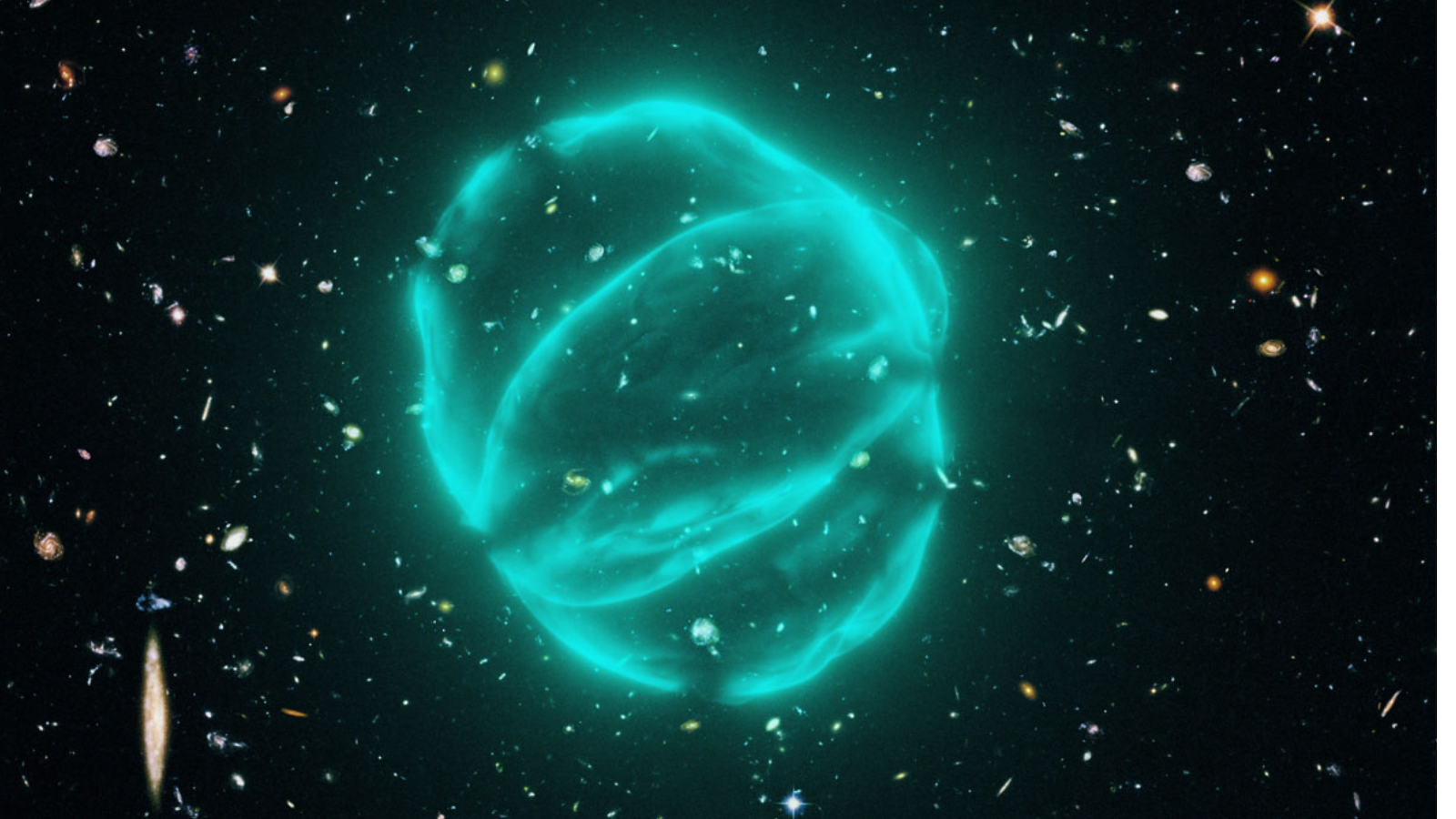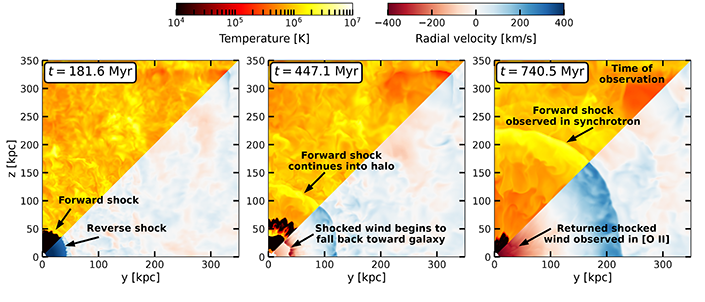The mystery of vast 'cosmic ORCs' — odd radio circles that encompass entire galaxies — may be solved
Astronomers have pointed to winds from bursts of supernova star explosions as the cause of huge and eerie "odd radio circles."

Scientists may finally have solved the mystery of cosmic ORCs, or "odd radio circles" as they are officially known, that are so vast they are 10 times the width of the Milky Way and can encompass entire galaxies.
A team of astronomers led by University of California San Diego Professor of Astronomy and Astrophysics Alison Coil have pointed toward powerful winds erupting from bursts of exploding stars, or supernovas, as the cause of vast shells of gas that are seen in radio waves as ORCs. The research was unveiled Wednesday (Jan. 8) at the 243rd meeting of the American Astronomical Society in New Orleans.
ORCs were first spotted by the Australian Square Kilometer Array Pathfinder (ASKAP) in 2019 and represented something truly puzzling that astronomers had never seen before.
Coil and her team used the integral field spectrograph at the W.M. Keck Observatory on the inactive volcano Maunakea on the island of Hawaii to look at the radio circle ORC 4, finding within it highly compressed gas and stars with a rough age of 6 billion years. This suggested to the team that these radio circles could be created when multiple stars explode near-simultaneously in the same galaxy.
Related: Cosmic orcs? Scientists snap best image yet of eerie 'odd radio circles' in space
Do cosmic ORCs tell a tale of stars from cradle to grave?
When massive stars reach the end of their lives and erupt in supernova blasts, vast amounts of stellar material are expelled as powerful winds into their surrounding galaxy.
Coil and colleagues think that if enough supernovas happen in the same region of space at roughly the same time, these winds can be driven to speeds as great as 4.5 million miles per hour, about 5,000 times as fast as a bullet fired from a handgun.
Breaking space news, the latest updates on rocket launches, skywatching events and more!
The question is, what kind of galaxies would harbor so many stars exploding at around the same time?
This could happen in galaxies that have experienced bouts of intense star formation, which astronomers call "starburst" galaxies.
“These galaxies are really interesting,” Coil said in a statement. “They occur when two big galaxies collide. The merger pushes all the gas into a very small region, which causes an intense burst of star formation."
The massive stars formed in such a merger-triggered-bout of rapid star formation burn through their fuel for nuclear fusion at the same rapid rates, erupting in supernova explosions and expelling gas as outflowing winds at similar times.
As these winds rip outwards from these starburst galaxies, they hit slower-moving gas around the galaxy. This interaction creates a shockwave that generates ORCs, which can spread out for hundreds of thousands of light-years. To put this into context, the Milky Way is around 98,000 light-years wide and one light-year is the distance light travels in a year, about 6 trillion miles (9.7 trillion kilometers).
Solving the mystery of cosmic ORCs
Prior to the development of this starburst galaxy-driven supernova-wind theory, scientists had suggested several other creation mechanisms to explain ORCs. These included the merger of two black holes and the creation of planetary nebulas during the supernova explosions that marks the end of a star's life.
The problem was that ORCs had only been seen in radio waves, and this data wasn't sufficient to distinguish between possible creation models.
Suspecting that ORCs could be the result of later stages of starburst galaxies that they had been investigating, Coil and her team began studying ORC 4, the first example of these radio shells to be discovered that is visible from the Northern Hemisphere, with the integral field spectrograph at the W.M. Keck Observatory. This revealed to them a huge amount of bright, highly compressed gas.
Continuing their detective work and using radio wave data and optical light observations, the team found that the stars within ORC 4 were around 6 billion years old, implying to them a burst of intense star formation had occurred at the heart of this radio circle that ended around 1 billion years ago.
The team then turned to a computer simulation developed by research co-author and Harvard & Smithsonian Center for Astrophysics galactic winds specialist Cassandra Lochhaas to further their investigation.
The simulation allowed the team to watch the development of ORC 4 over the course of 750 million years, just short of its estimated 1 billion-year existence.
Replicating the size and properties of ORC 4 and accounting for the huge amount of shocked gas in the galaxy at its heart, the simulation showed galactic winds flowing outwards for a period of around 200 million years.
Even when these winds halted, the shock wave they launched continued to force its way forward, blasting hot gas out of the galaxy, creating the radio ring that encompasses it, and also causing cooling gas to fall back into the galaxy.
"To make this work you need a high-mass outflow rate, meaning it's ejecting a lot of material very quickly. And the surrounding gas just outside the galaxy has to be low-density; otherwise, the shock stalls. These are the two key factors," Coil said. "It turns out the galaxies we’ve been studying have these high-mass outflow rates.
"They're rare, but they do exist. I really do think this points to ORCs originating from some kind of outflowing galactic winds."
The revelation that ORCs like ORC 4 are likely the result of outflowing galactic winds means these radio circles can be used as a proxy to study these powerful winds and answer important questions about galactic evolution.
"ORCs provide a way for us to 'see' the winds through radio data and spectroscopy. This can help us determine how common these extreme outflowing galactic winds are and what the wind life cycle is," said Coil. "They can also help us learn more about galactic evolution: do all massive galaxies go through an ORC phase? Do spiral galaxies turn elliptical when they are no longer forming stars?
"I think there is a lot we can learn about ORCs and learn from ORCs."
In addition to being presented at the American Astronomical Society meeting in new Orleans, the team's research is also detailed in the in the Jan. 8 edition of the journal Nature.

Robert Lea is a science journalist in the U.K. whose articles have been published in Physics World, New Scientist, Astronomy Magazine, All About Space, Newsweek and ZME Science. He also writes about science communication for Elsevier and the European Journal of Physics. Rob holds a bachelor of science degree in physics and astronomy from the U.K.’s Open University. Follow him on Twitter @sciencef1rst.


